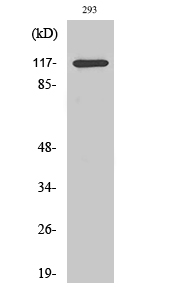Total HDAC4 Cell-Based Colorimetric ELISA Kit
- 货号:KA4114C
- 应用:ELISA
- 种属:Human;Mouse;Rat
- 基因名称:
- HDAC4
- Human Gene Id:
- 9759
- Human Swiss Prot No:
- P56524
- Mouse Swiss Prot No:
- Q6NZM9
- Rat Swiss Prot No:
- Q99P99
- 储存:
- 2-8°C/6 months
- 其他名称:
- Histone deacetylase 4 (HD4) (EC 3.5.1.98)
- 检测方法:
- Colorimetric
- 背景:
- catalytic activity:Hydrolysis of an N(6)-acetyl-lysine residue of a histone to yield a deacetylated histone.,domain:The nuclear export sequence mediates the shuttling between the nucleus and the cytoplasm.,function:Responsible for the deacetylation of lysine residues on the N-terminal part of the core histones (H2A, H2B, H3 and H4). Histone deacetylation gives a tag for epigenetic repression and plays an important role in transcriptional regulation, cell cycle progression and developmental events. Histone deacetylases act via the formation of large multiprotein complexes. Involved in muscle maturation via its interaction with the myocyte enhancer factors such as MEF2A, MEF2C and MEF2D.,PTM:Phosphorylated by CaMK4 at Ser-246, Ser-467 and Ser-632. Phosphorylation at other residues is required for the interaction with 14-3-3.,PTM:Sumoylation on Lys-559 is promoted by the E3 SUMO-protein ligase RANBP2, and prevented by phosphorylation by CaMK4.,similarity:Belongs to the histone deacetylase family. Type 2 subfamily.,subcellular location:Shuttles between the nucleus and the cytoplasm. Upon muscle cells differentiation, it accumulates in the nuclei of myotubes, suggesting a positive role of nuclear HDAC4 in muscle differentiation. The export to cytoplasm depends on the interaction with a 14-3-3 chaperone protein and is due to its phosphorylation at Ser-246, Ser-467 and Ser-632 by CaMK4. The nuclear localization probably depends on sumoylation.,subunit:Interacts with HDAC7 (By similarity). Homodimer. Homodimerization via its N-terminal domain. Interacts with MEF2C, AHRR, and NR2C1. Interacts with a 14-3-3 chaperone protein in a phosphorylation dependent manner. Interacts with BTBD14B (By similarity). Interacts with KDM5B.,tissue specificity:Ubiquitous.,
- 功能:
- negative regulation of transcription from RNA polymerase II promoter, skeletal system development, cell activation,immune system development, leukocyte differentiation, muscle system process, regulation of carbohydrate metabolic process, regulation of glycolysis, chromatin organization, chromatin remodeling, transcription, regulation of transcription, DNA-dependent, regulation of transcription from RNA polymerase II promoter, protein amino acid deacetylation, defense response, inflammatory response, positive regulation of cell proliferation, negative regulation of cell proliferation, response to wounding, negative regulation of biosynthetic process, positive regulation of biosynthetic process, regulation of catabolic process, negative regulation of catabolic process, response to organic substance, regulation of specific transcription from RNA polymerase II promoter, positive regulation o
- 细胞定位:
- Nucleus. Cytoplasm. Shuttles between the nucleus and the cytoplasm. Upon muscle cells differentiation, it accumulates in the nuclei of myotubes, suggesting a positive role of nuclear HDAC4 in muscle differentiation. The export to cytoplasm depends on the interaction with a 14-3-3 chaperone protein and is due to its phosphorylation at Ser-246, Ser-467 and Ser-632 by CaMK4 and SIK1. The nuclear localization probably depends on sumoylation. Interaction with SIK3 leads to HDAC4 retention in the cytoplasm (By similarity). .
- 组织表达:
- Ubiquitous.
- June 19-2018
- WESTERN IMMUNOBLOTTING PROTOCOL
- June 19-2018
- IMMUNOHISTOCHEMISTRY-PARAFFIN PROTOCOL
- June 19-2018
- IMMUNOFLUORESCENCE PROTOCOL
- September 08-2020
- FLOW-CYTOMEYRT-PROTOCOL
- May 20-2022
- Cell-Based ELISA│解您多样本WB检测之困扰
- July 13-2018
- CELL-BASED-ELISA-PROTOCOL-FOR-ACETYL-PROTEIN
- July 13-2018
- CELL-BASED-ELISA-PROTOCOL-FOR-PHOSPHO-PROTEIN
- July 13-2018
- Antibody-FAQs


.jpg)